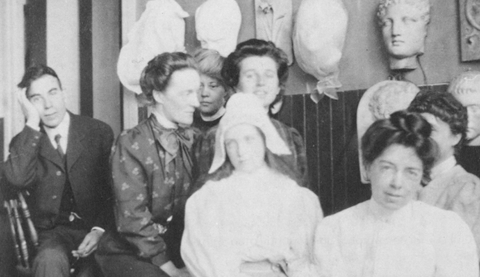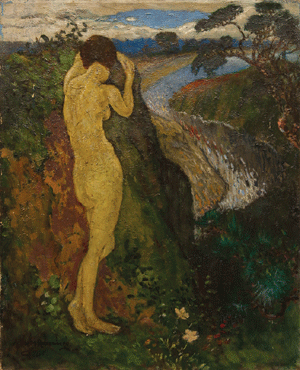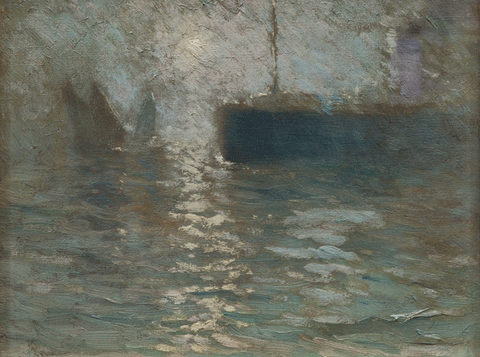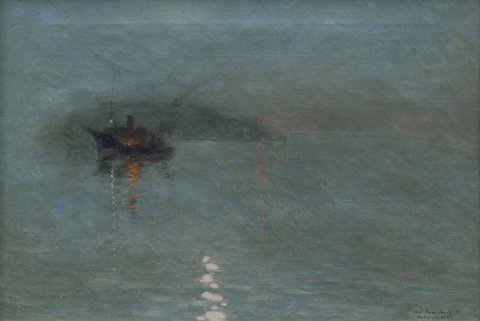
When Mora Dianne O’Neill got to the stage of organizing Reinvention: The Art and Life of HM Rosenberg for the walls of the Art Gallery of Nova Scotia, she didn’t know where to start. As she says, “How do you install paintings that don’t look like each other?”You see Henry Mortikar Rosenberg didn’t really have a quintessential Henry Mortikar Rosenberg style. Sometimes his paintings were Impressionist, sometimes Tonalist, sometimes like the Group of Seven. Sometimes they looked like they could have been painted by Whistler, sometimes by Sargent, sometimes by Cezanne.
“Why didn’t he develop a particular Rosenberg style? He seemed to react to the moment and let his immediate world dictate what his response should be,”muses Dr. O’Neill. “We can’t subtract the century from our thinking, but he was incredibly modern and he doesn’t get credit for that. Today, his paintings look traditional, but when he did them they were radical.”
Internationally acclaimed in his day, Rosenberg (1858-1947) is less known today. Dr. O’Neill hopes Reinvention: The Art and Life of HM Rosenberg will change that, although it may be difficult for the contemporary viewer to fully appreciate his talent or his influence on the artistic scene in Halifax.
“Looking at Rosenberg’s nudes today, they seem incredibly old-fashioned. But he was painting them into contemporary landscapes, which just wasn’t done.”
— Mora Dianne O’Neill, curator of Reinvention: The Art and Life of HM Rosenberg.

Rosenberg, educated in Chicago, Munich, Florence and Venice, arrived in Halifax in 1896. Two years later, he became the principal of the Victoria School of Art and Design (now known as NSCAD University) and served for 12 years. He might have worked there longer, but in 1909 he married heiress Emily Scarfe, who “didn’t want him to take a salary,” says Dr. O’Neill. Following a round-the-world cruise, the couple settled into Edgemere, a Victorian mansion above Sullivan’s Pond in Dartmouth. Rosenberg maintained his studio in Halifax and took the ferry across the harbor most days.
Dr. O’Neill started researching Rosenberg’s life and work starting in 2008. Besides the question of why he didn’t develop his own recognizable style, there were other mysteries to puzzle over.
Why, for example, is his association with James McNeill Whistler, one of the leading artists of the 19th century, doubted—as it is by Donald Soucy and Harold Pearse, authors of The First Hundred Years: A History of the Nova Scotia College of Art and Design? (Dr. O’Neill, for her part, sees no reason to be skeptical. As one of the “Duveneck boys,” Rosenberg would have certainly spent time with Whistler while in Venice. He is also named personally by Whistler in correspondence which she discovered in the Whistler Archive at the University of Glasgow.) Did anti-Semitism douse any acclaim that Rosenberg, who was Jewish, might have been otherwise accorded? And, what exactly are those Impressionistic paintings dating to 1917 depicting? Could they be paintings of the harbor during the Halifax Explosion? Dr. O’Neill believes so.
“I think this is the Mont Blanc on fire,” she says, pointing to a photocopy of one painting. Innocuously named “Storm,” it’s a hazy grey painting of the harbor punctuated with a burst of fiery gold and red.
“And I think this one might be Richmond in flames,” she adds of a watercolor called “Seaside Reflections.”
During the explosion, Rosenberg was on the upper deck of the ferry watching the Mont Blanc burn; the force of the blast slammed him and the other curious onlookers to the deck. Injured by flying glass, the people inside the ferry fared much worse. Later, his home, Edgemere, would be used as a medical aid station to care for victims of the blast.
If the paintings are indeed of the harbor during the Halifax Explosion, they would be extremely rare. Artists were not allowed to paint the harbor during wartime, something that certainly got Arthur Lismer (one of Rosenberg’s successors as principal of the Victoria School of Art and Design) in trouble until he was formally named a Canadian war artist.
“It’s possible in all the confusion he was able to make the sketch or perhaps he made it from memory,” speculates Dr. O’Neill. “He’s reacting to what he sees as an artist. He’s reacting to the colour.”



